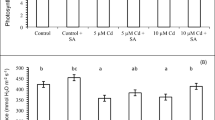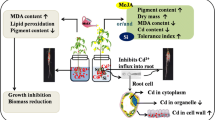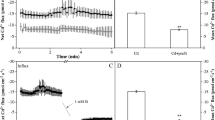Abstract
The present study has been conducted to evaluate the impact of silicon (Si) and salicylic acid (SA) in the regulation of Cd-induced toxicity in maize seedlings. Cadmium (Cd: 100 µM) significantly reduced root and shoot fresh weight and length, photosynthetic pigments, total soluble protein content and chlorophyll fluorescence parameters. Cadmium decreased root and shoot length by 23 and 19% and fresh weight by 27 and 24%, respectively when compared to their respective controls. Similarly, total chlorophyll, carotenoids and total soluble protein were decreased by 21, 18 and 28%, respectively by Cd. In contrast, the addition of SA (500 µM) and Si (10 µM), and their combination (SA + Si) together with Cd treatment successfully ameliorated Cd-induced harmful impacts on studied parameters as SA and Si alone and in combination reduced Cd accumulation and oxidative stresses and thus refurbish the damages. Cd significantly stimulated activity of superoxide dismutase while inhibited activities of ascorbate peroxidase (APX), glutathione reductase (GR) and dehydroascorbate reductase (DHAR), and declined total ascorbate and glutathione contents. In contrast, the addition of SA and Si alone and in combination stimulated the activities of APX, GR and DHAR and significantly increased levels of total ascorbate and glutathione. In conclusion, the present study suggested that although SA and Si both alone are able to alleviate Cd-induced toxicity in maize seedlings, but their combination was the most effective in nullifying Cd-induced toxicity in maize seedlings.





Similar content being viewed by others
Abbreviations
- SA:
-
Salicylic acid
- AsA:
-
Reduced ascorbate
- APX:
-
Ascorbate peroxidase
- DHA:
-
Dehydroascorbate
- DHAR:
-
Dehydroascorbate reductase
- Fv/Fm:
-
Maximum photochemical efficiency of PS II
- GR:
-
Glutathione reductase
- H2O2 :
-
Hydrogen peroxide
- MDA:
-
Malondialdehyde
- NPQ:
-
Non-photochemical quenching
- qP:
-
Photochemical quenching
- ROS:
-
Reactive oxygen species
- Si:
-
Silicon
- SOD:
-
Superoxide dismutase
- SOR:
-
Superoxide radical
References
An C, Mou Z (2011) Salicylic acid and its function in plant immunity. J Integer Plant Biol 53:412–428. https://doi.org/10.1111/j.1744-7909.2011.01043.x
Arberg B (1981) Plant growth regulators. XLI. Monosubstituted benzoic acid. Swed J Agric Res 11:93–105
Arditti J, Dunn A (1969) Environmental plant physiology—experiments in cellular and plant physiology. Rinehart and Winston Inc, Holt
Asgher M, Khan MIR, Anjum NA, Khan NA (2014) Minimising toxicity of cadmium in plants—role of plant growth regulators. Protoplasma 252:399–413
Barceló JUAN, Poschenrieder C (1990) Plant water relations as affected by heavy metal stress: a review. J Plant Nutr 13(1):1–37
Belkadhi A, De Haro A, Obregon S, Chaı¨bi W, Djebali W (2015) Positive effects of salicylic acid pretreatment on the composition of flax plastidial membrane lipids under cadmium stress. Environ Sci Pollut R 22(2):1457–1467
Bernard A (2008) Cadmium and its adverse effects on human health. Indian J Med Res 128(4):557
Brehe JE, Burch HB (1976) Enzymatic assay for glutathione. Anal Biochem 74:189–197
Chen Z, Zheng Z, Huang J, Lai Z, Fan B (2009) Biosynthesis of salicylic acid in plants. Plant Signal Behav 4(6):493–496
Cui W, Li L, Gao Z, Wu H, Xie Y, Shen W (2012) Haem oxygenase-1 is involved in salicylic acid-induced alleviation of oxidative stress due to cadmium stress in Medicago sativa. J Exp Bot 63:5521–5534
Drazic G, Mihailovic N (2005) Modification of cadmium toxicity in soybean seedlings by salicylic acid. Plant sci 168(2):511–517
Elstner EF, Heupel A (1976) Inhibition of nitrite formation from hydroxyl ammonium chloride: a simple assay for superoxide dismutase. Anal Biochem 70:616–620
Epstein E (1999) Annual review of plant physiollogy and plant molecular biology. Silicon 50:641–664
Foyer CH, Noctor G (2011) Ascorbate and glutathione: the heart of the redox hub. Plant Physiol 155(1):2–18
Friberg L (2017) Cadmium in the environment. CRC Press, Boca Raton
Giannopolitis CN, Reis SK (1977) Superoxide dismutase. I. Occurrence in higher plants. Plant Physiol 59:309–314. https://doi.org/10.1104/pp.59.2.309
Gill SS, Khan NA, Anjum NA, Tuteja N (2011) Amelioration of cadmium stress in crop plants by nutrients management: morphological, physiological and biochemical aspects. Plant Stress 5(1):1–23
Gonçalves JF, Antes FG, Maldaner J, Pereira LB, Tabaldi LA, Rauber R, Rossato LV, Bisognin DA, Dressler VL, Flores EM, Nicoloso FT (2009) Cadmium and mineral nutrient accumulation in potato plantlets grown under cadmium stress in two different experimental culture conditions. Plant Physiol Biochem 47:814–821
Gossett DR, Millhollon EP, Cran LM (1994) Antioxidant response to NaCl stress in salt-sensitive cultivars of cotton. Crop Sci 34:706–714
Guo Q, Meng L, Mao P-C, Jia Y-Q, Shi Y-J (2013) Role of exogenous salicylic acid in alleviating cadmium-induced toxicity in Kentucky bluegrass. Biochem Syst Ecol 50:269–276
Hayat Q, Hayat S, Irfan M, Ahmad A (2010) Effect of exogenous salicylic acid under changing environment: a review. Environ Exp Bot 68(1):14–25
He JL, Li H, Luo J, Ma CF, Li SJ, Qu L, Gai Y, Jiang X, Janz D, Polle A, Tyree M (2013) A transcriptomic network underlies microstructure and physiological responses to cadmium in Populus canescens. Plant Physiol 162:424–439
Heath RL, Packer L (1968) Photoperoxidation in isolated chloroplasts I. Kinetics and stoichiometry of fatty acid peroxidation. Arch Biochem Biophys 125:189–198
Horiguchi T, Morita S (1987) Mechanism of manganese toxicity and tolerance of plants VI. Effect of silicon on alleviation of manganese toxicity of barley. J Plant Nutr 10:2299–2310. https://doi.org/10.1080/01904168709363778
Janda T, Gondor OK, Yordanova R, Szalai G, Pa´l M (2014) Salicylic acid and photosynthesis: signalling and effects. Acta Physiol Plant 36:2537–2546
Kawano T, Bouteau F (2013) Crosstalk between intracellular and extracellular salicylic acid signaling events leading to long-distance spread of signals. Plant Cell Rep 32:1125–1138. https://doi.org/10.1007/s00299-013-1451-0
Khan MIR, Fatma M, Per TS, Anjum NA, Khan NA (2015) Salicylic acid-induced abiotic stress tolerance and underlying mechanisms in plants. Front Plant Sci 6:462
Kulaeva OA, Tsyganov VE (2011) Molecular-genetic basis of cadmium tolerance and accumulation in higher plants. Russian J Genet 1(5):.349
Li X, Ma L, Bu N, Li Y, Zhang L (2014) Effects of salicylic acid pretreatment on cadmium and/or UV-B stress in soybean seedlings. Biol Plant 58:195–199
Lichtenthaler HK (1987) Chlorophylls and carotenoids: pigments of photosynthetic biomembranes. Methods Enzymol 148:350–382
Liu J, Zhu Q, Zhang Z, Xu J, Yang J, Wong MH (2004) Variations in cadmium accumulation among rice cultivars and types and the selection of cultivars for reducing cadmium in the diet. J Sci Food Agric 85:147–153
Liu Y, Xiao T, Baveye PC, Zhu J, Ning Z, Li H (2015) Potential health risk in areas with high naturally-occurring cadmium background in southwestern China. Ecotoxicol Environ Saf 112:122–131
Liu Z, Ding Y, Wang F, Ye Y, Zhu C (2016) Role of salicylic acid in resistance to cadmium stress in plants. Plant Cell Rep 35(4):719–731
Lowry OH, Rosebrough NJ, Farr AL, Randall RJ (1951) Protein measurement with the folin phenol reagent. J Biol Chem 193:265–275
Lux A, Luxova´ M, Hattori T, Inanaga S, Sugimoto Y (2002) Silicification in sorghum (Sorghum bicolor) cultivars with different drought tolerance. Physiol Plant 115:87–92
Metwally A, Finkemeier I, Georgi M, Dietz KJ (2003) Salicylic acid alleviates the cadmium toxicity in barley seedlings. Plant Physiol 132(1):272–281
Mitani-Ueno N, Yamaji N, Ma F (2016) High silicon accumulation in the shoot is required for down-regulating the expression of Si transporter genes in rice. Plant Cell Physiol 57:2510–2518
Mittler R (2002) Oxidative stress, antioxidants and stress tolerance. Trends Plant Sci 7:405–410
Muneer S, Park YG, Kim S, Jeong BR (2017) Foliar or Sub irrigation silicon supply mitigates high temperature stress in strawberry by maintaining photosynthetic and stress-responsive proteins. J Plant Growth Regul 36(4):836–845
Nakano Y, Asada K (1981) Hydrogen peroxide is scavenged by ascorbate specific peroxidase in spinach chloroplasts. Plant Cell Physiol 22:867–880
Nwugo CC, Huerta AJ (2008) Effects of silicon nutrition on cadmium uptake, growth and photosynthesis of rice plants exposed to low-level cadmium. Plant Soil 311:73–86
Popova LP, Maslenkova LT, Yordanova RY, Ivanova AP, Krantev AP, Szalai G, Janda T (2009) Exogenous treatment with salicylic acid attenuates cadmium toxicity in pea seedlings. Plant Physiol Biochem 47(3):224–231
Raskin I (1992) Role of salicylic acid in plants. Annu Rev Plant Biol 43(1):439–463
Rivas-San Vicente M, Plasencia J (2011) Salicylic acid beyond defence: its role in plant growth and development. J Exp Bot 62(10):3321–3338
Sairam RK, Rao KV, Srivastava GC (2002) Differential response of wheat genotypes to long term salinity stress in relation to oxidative stress, antioxidant activity and osmolyte concentration. Plant Sci 163(5):1037–1046
Schaedle M, Bassham JA (1977) Chloroplast glutathione reductase. Plant Physiol 59:1011–1022
Sfaxi-Bousbih A, Chaoui A, El Ferjani E (2010) Cadmium impairs mineral and carbohydrate mobilization during the germination of bean seeds. Ecotox Environ Safe 73(6):1123–1129
Shah K, Kumar RG, Verma S, Dubey RS (2001) Effect of cadmium on lipid peroxidation superoxide anion generation and activities of antioxidant enzymes in growing rice seedling. Plant Sci 161:1135–1144
Shi Q, Bao Z, Zhu Z, He Y, Qian Q, Yu J (2005) Silicon-mediated alleviation of Mn toxicity in Cucumis sativus in relation to activities of superoxide dismutase and ascorbate peroxidase. Phytochemistry 66:1551–1559. https://doi.org/10.1016/j.phytochem.2005.05.006
Shi G, Cai Q, Liu Q, Wu L (2009) Salicylic acid-mediated alleviation of cadmium toxicity in hemp plants in relation to cadmium uptake, photosynthesis, and antioxidant enzymes. Acta Physiol Plant 31:969–977
Shi X, Zhang Ch, Wang H, Zhang F (2005) Effect of Si on the distribution of Cd in rice seedlings. Plant Soil 272:53–60
Singh S, Prasad SM (2013) Foliar application of salicylic acid minimizes cadmium-induced toxicity in Solanum melongena L. seedlings through an improved antioxidant system. Biochem Cell Arch 13:383–393
Singh VP, Kumar J, Singh S, Prasad SM (2014) Dimethoate modifies enhanced UV-B effects on growth, photosynthesis and oxidative stress in mung bean (Vigna radiata L.) seedlings: Implication of salicylic acid. Pestic Biochem Physiol 116:13–23
Singh VP, Singh S, Tripathi DK, Prasad SM, Chauhan DK (eds) (2017) Reactive oxygen species in plants: boon or bane-revisiting the role of ROS. John Wiley & Sons, Hoboken
Singh VP, Tripathi DK, Kumar D, Chauhan DK (2011) Influence of exogenous silicon addition on aluminium tolerance in rice seedlings. Biol Trace Elem Res 144(1–3):1260–1274
Song J, Feng SJ, Chen J, Zhao WT, Yang ZM (2017) A cadmium stress-responsive gene AtFC1 confers plant tolerance to cadmium toxicity. BMC Plant Biol 17(1):187
Stork F, Backor M, Klejdus B, Hedbavny J, Kovacik J (2013) Changes of metalinduced toxicity by H2O2/NO modulators in Scenedesmus quadricauda (Chlorophyceae). Environ Sci Pollut Res 20:5502–5511
Strasser RJ, Srivastava A, Tsimilli-Michael M (2000) The fluorescence transient as a tool to characterize and screen photosynthetic samples. In: Yunus M, Pathre U, Mohanty P (eds) Probing photosynthesis: mechanisms, regulation and adaptation. Taylor & Francis, London, pp 445–483
Tripathi DK, Mishra RK, Singh S, Singh S, Singh VP, Singh PK, Chauhan DK, Prasad SM, Dubey NK, Pandey AC (2017) Nitric oxide ameliorates zinc oxide nanoparticles phytotoxicity in wheat seedlings: implication of the ascorbate-glutathione cycle. Front Plant Sci 8:1
Tripathi DK, Singh VP, Kumar D, Chauhan DK (2012a) Rice seedlings under cadmium stress: effect of silicon on growth, cadmium uptake, oxidative stress, antioxidant capacity and root and leaf structures. Chem Ecol 28(3):281–291
Tripathi DK, Singh VP, Kumar D, Chauhan DK (2012b) Impact of exogenous silicon addition on chromium uptake, growth, mineral elements, oxidative stress, antioxidant capacity, and leaf and root structures in rice seedlings exposed to hexavalent chromium. Acta Physiol Plant 34(1):279–289
Tripathi DK, Singh VP, Gangwar S, Prasad SM, Maurya JN, Chauhan DK (2014) Role of silicon in enrichment of plant nutrients and protection from biotic and abiotic stresses. In: Improvement of crops in the Era of climatic changes. Springer, New York, pp 39–56
Tripathi DK, Singh VP, Prasad SM, Chauhan DK, Dubey NK, Rai AK (2015) Silicon-mediated alleviation of Cr (VI) toxicity in wheat seedlings as evidenced by chlorophyll florescence, laser induced breakdown spectroscopy and anatomical changes. Ecotoxicol Environ Saf 113:133–144
Tripathi DK, Singh S, Singh VP, Prasad SM, Chauhan DK, Dubey NK (2016) Silicon nanoparticles more efficiently alleviate arsenate toxicity than silicon in maize cultiver and hybrid differing in arsenate tolerance. Front Environ Sci 4:46
Vaculík M, Landberg T, Greger M, Luxová M, Stoláriková M, Lux A (2012) Silicon modifies root anatomy, and uptake and subcellular distribution of cadmium in young maize plants. Ann Bot-Londonn 110(2):433–443
Vaculík M, Pavlovič A, Lux A (2015) Silicon alleviates cadmium toxicity by enhanced photosynthetic rate and modified bundle sheath’s cell chloroplasts ultrastructure in maize. Ecotoxicol Environ Saf 120:66–73
Velikova V, Yordanov I, Edreva A (2000) Oxidative stress and some antioxidant system in acid rain-treated bean plants. Plant Sci 151:59–66
Vitória AP, Lea PJ, Azevedo RA (2001) Antioxidant enzymes responses to cadmium in radish tissues. Phytochemistry 57(5):701–710
Wang Q, Liang X, Dong Y, Xu L, Zhang X, Kong J, Liu S (2013) Effects of exogenous salicylic acid and nitric oxide on physiological characteristics of perennial ryegrass under cadmium stress. J Plant Growth Regul 32:721–731
Wu FB, Chen FK, Wei KG, Zhang P (2004) Effects of cadmium on free amino acids, glutathione, and ascorbic acid concentration in two barley genotypes (Hordeum vulgare L.) differing in cadmium tolerance. Chemosphere 57:447–454
Xu WF, Shi WM, Yan F, Zhang B, Liang JS (2011) Mechanisms of cadmium detoxification in cattail (Typha angustifolia L.). Aqua Bot 94:37–43
Zhang Y, Xu S, Yang S, Chen Y (2015) Salicylic acid alleviates cadmium-induced inhibition of growth and photosynthesis through upregulating antioxidant defense system in two melon cultivars (Cucumis melo L.). Protoplasma 252:911–924
Acknowledgements
Swati Singh is thankful to the University Grants Commission, New Delhi for providing D. Phil Fellowship. The authors are thankful to UGC for providing FIST Grant to the Department of Botany University of Allahabad.
Author information
Authors and Affiliations
Corresponding authors
Ethics declarations
Conflict of interest
Authors declared that they do not have any conflict of interest.
Additional information
Publisher’s Note
Springer Nature remains neutral with regard to jurisdictional claims in published maps and institutional affiliations.
Rights and permissions
About this article
Cite this article
Singh, S., Singh, V.P., Prasad, S.M. et al. Interactive Effect of Silicon (Si) and Salicylic Acid (SA) in Maize Seedlings and Their Mechanisms of Cadmium (Cd) Toxicity Alleviation. J Plant Growth Regul 38, 1587–1597 (2019). https://doi.org/10.1007/s00344-019-09958-1
Received:
Accepted:
Published:
Issue Date:
DOI: https://doi.org/10.1007/s00344-019-09958-1




